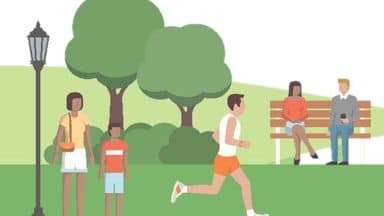A study carried out by IFOP for ECT on the expectations of town-dwellers relating to « vert en ville » or greening the city
With the municipal elections coming up, ECT, developer of sustainable projects using soil from construction and public works sites, unveils the results of a survey* carried out by IFOP on town-dwellers and « greening the city ». Involving more than 2000 urbanites, the study shows the strong attachment of town-dwellers to green spaces and to their benefits. Most French people who spend time in the green spaces are happy with them. However, the 18-35 generation of Millennials stands out. They have much greater expectations about the use of green spaces. With the approach of the municipal elections, this is a political issue because 72% of people in the survey said that the question of « greening the city » would play a major or decisive role in the polling booth.
« Townspeople have real expectations, in terms of the creation and development of green spaces, but also in terms of facilities and services. Urban farms, linear parks and green corridors, land art, sports installations, and so on. It is vital to tackle this fundamental issue for the well-being of residents », emphasizes Laurent Mogno, chairman of ECT.
IFOP’s analysis is that « the study shows that ‘Millennials’ have a generational aspiration towards there being more green spaces in cities, and more facilities for the things that interest them. A significant gap has opened up between them and the Baby-boomer generation, who are satisfied with green spaces and equipment in their current state. »
Overall satisfaction, but higher expectations on the part of the 18-35s
- 74% of French town-dwellers are satisfied with the number of squares, parks, gardens and green spaces in their commune.
The average amongst the 18-35s: 63% - 66% of those surveyed would go there more often if the number of such spaces increased.
The average amongst the 18-35s: 73% - 60% of those surveyed would go more often to the green spaces in their town if there were more facilities (sports, games, relaxation spaces, etc)
The average for the 18-35s: 75% - 59% of those surveyed would go more often to the green spaces in their commune if there were more activities (gardening, sports courses, workshops, etc)
The average for the 18-35s: 72%
Half of city-dwellers consider that there are enough :
- Children’s play areas (50%)
- Parks and gardens (49%),
- Outdoor sports installations (45%),
- Woods and natural spaces for flora and fauna (45%)
But the 18-35s stand out and express frustration:
- Only 43% are satisfied with the quantity of parkland, gardens and green spaces in their communes – 6 points less than the national average
- As regards sports in town, 37% are satisfied – 8 points less than the national average
- And for areas dedicated to the conservation of flora and fauna, 39% are satisfied – 6 points below the national average
A close link, and recognition of the benefits of « greening the city »
All the French believe in the benefits of green spaces :
- On the personal level: 92% believe that green spaces in the city improve morale.
- As a social bonding factor: 82% think that « greening the city » contributes to reinforcing the social bonds between residents.
- As a direct contribution towards the environment: 92% see them as islands of freshness in city centres. 91% see them as a factor in improving air quality. And 89% see an opportunity to create places for biodiversity.
Places at the heart of their everyday life for 7 town-dwellers out of 10
Green spaces thus constitute part of everyday life for town-dwellers. 7 out of 10 say they spend time in a park, square or public garden in their commune at least once a month; at least once a week for 34%, and every day for 4%. Only 29% of city dwellers say that they never spend time in green spaces.
This close and very strong link between the French and green spaces can be explained in terms of the geographical distribution of green spaces:
- 36% of town-dwellers said they live less than 5 minutes on foot from a square, park or public garden,
- 34% between 5 & 10 minutes away on foot, 19% between 11 and 20 minutes away
- and 11% more than 20 minutes away.
As regards leisure activities:
- 88% of town-dwellers who were asked said that they go for walks there
- 71% of people who were asked said that they did relaxation and leisure activities there (picnics, reading, sunbathing, etc).
- 64% of respondents go more for games and family activities
- 63% do a sports activity in the open air.
- 46% of town-dwellers (which is almost one person in two) who were asked would do more gardening if the infrastructure was there to make this possible.
Methodology of the study
The survey was carried out with a sample of 2,005 town-dwellers who were representative of the adult population of urban communes in mainland France.
To ensure that the overall sample was representative, quotas were used for:
- Socio-demographic criteria: The gender of the individual; the age of the individual;
- Socio-occupational criteria: The individual’s profession;
- Geographic criteria: The region and size of the urban unit of the commune of residence.
These quotas were defined using INSEE data for the population aged 18 or above and living in mainland France (Enquête Emploi 2015).
The interviews were carried out with self-administered online questionnaires between 31 January and 3 February 2020.

